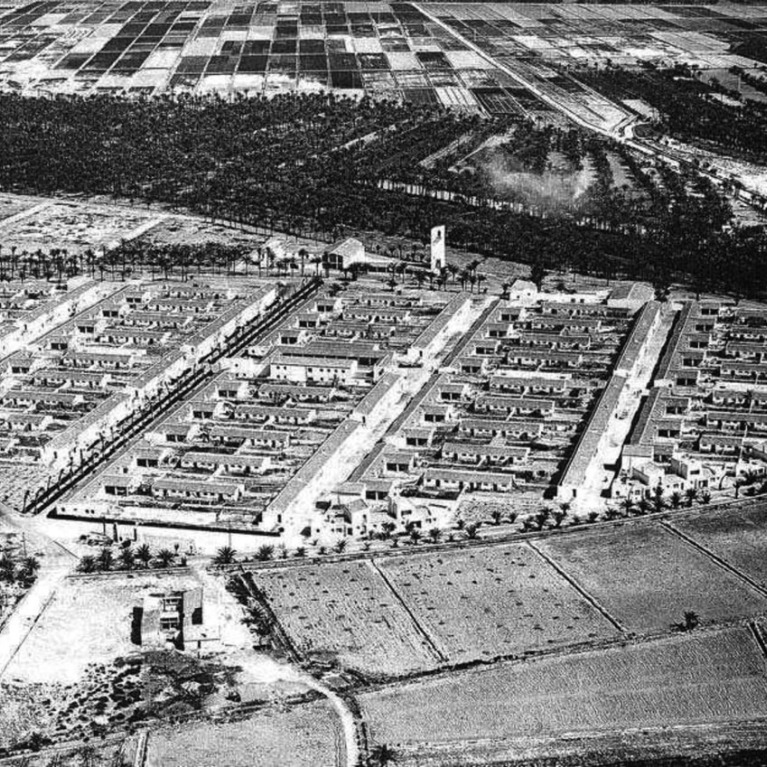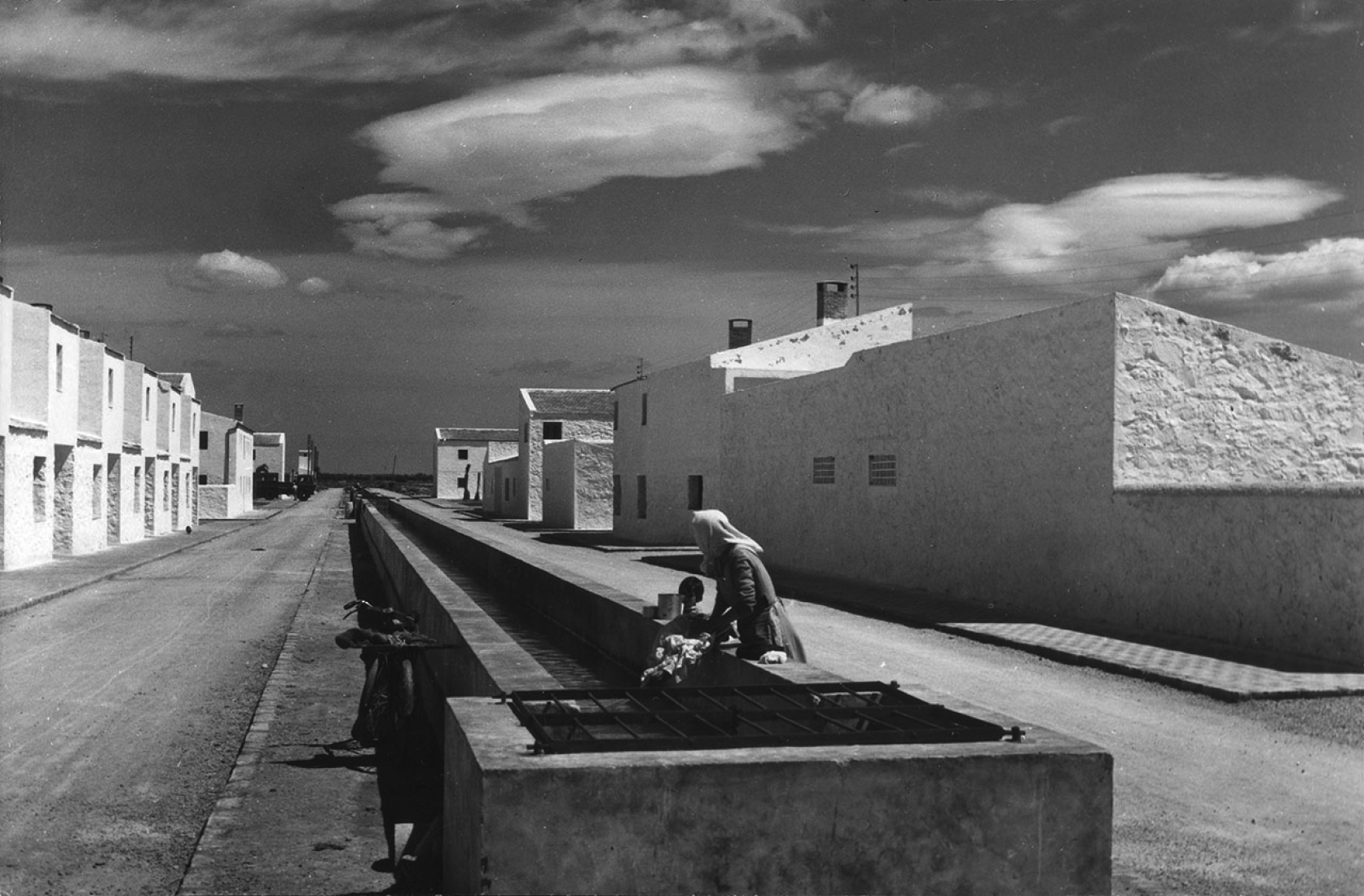
[Fig. 1] Planimetry of type E of a house for settlers from Vegaviana. Source: Image by courtesy of Rafael Fernández del Amo.

[Fig. 2] Planimetry of a house for workingmen from Vegaviana. Source: Image by courtesy of Rafael Fernández del Amo.
The entrance from the street to the dwelling is made through a small porch in the case of the central housings, and in a direct way in the rest of the homes. The exit to the patio is also made without any transition zones. The roofs are sloping, as in the other cases. At the same time, the materials and the construction systems are the same in all the houses, not only in the settlers´ houses but also in the workingmen´s ones, and they are the typical of the surroundings.
One of the distinguishing aspects more relevant with the settlers´ dwellings was the patio. It was so due to the fact that – besides the patio size- this type of house did not include agricultural rooms in its back of the patio, as we have already mentioned, that is why it did not have any bathroom, neither had it a double entry nor circulation. There is only an entrance through the main façade, since there are also storm doors creating an urban double-façade, protecting the private patios towards the inside of the generated block.
Both the architectural composition and the interior design of the houses for workingmen related them to the place and climate. In this way, they try to economise the heat input of the home zone with the arrangement of the rooms around itself. Even those that had a top floor placed their rooms just above. All of them included a big air chamber under the roof that served as insulation, and they looked for having compact forms generally, protecting their sides and opening their facades to the outside, to the landscape. However, and as we have already mentioned, only the central housings possessed those exterior-interior transitional spaces as a kind of porch that would protect them from the external environment, from the cold as well as from the Extremaduran heat.

[Fig. 3] Houses for settlers picture from Vegaviana. Source: Fernández del Amo, José Luis. Un poblado de colonización, Vegaviana. Revista Nacional de Arquitectura, núm. 202, 1958, p.13.
The houses for workingmen had, therefore, the same importance as the settlers´ones, although they found themselves in a much smaller number. The relationship with the vegetation, its privileged location in the village, and a careful design that made the dwellings more comfortable, they all werre the common features in both types of houses, different at the beginning, similar essentially. This circumstance in which the labourer was in a main perspective does not take place in all de Fernández del Amo´s villages of colonization. For instance, in San Isidro de Albatera, the houses for workingmen were placed in triangular sites that were generated after having the settlers´ ones as a priority. (1). In Cañada de Agra, the houses for labourers were placed next to the public buildings and people can access to them from a street in the cul-de-sac (2).

[Fig. 4] Aerial view from San Isidro de Albatera. Source: Paisajes Españoles S.A.

[Fig. 5] Aerial view from Cañada de Agra. Fuente: Paisajes Españoles S.A.

[Fig. 6] Settler´s house in Vegaviana. Source: http://jesarqit.wordpress.
The author expressed the own idea from which Vegaviana was born in the proclamation of the village patron saint festivities in 1990 through the question “Why don´t build the village in the middle of itself, respecting the big trees and even trying to preserve and replace the assisted spontaneous vegetation of plants as a garden among its houses and surroundings, as an urban ring of recreation?”(3), it implied that environmental and ethical work that the architect considered typical of his work. The houses for the workingmen, centerpieces of the general organization, had the same importance, being part of the environment and being related with the existing vegetation and the recreational areas just as the settlers´ homes, grounds of the village.
NOTES.-
(1) Centellas Soler, Miguel. “Los pueblos de colonización de Fernández del Amo. Arte, arquitectura y urbanismo”. Fundación Caja de Arquitectos, Barcelona, 2010, p. 57.
(2) Ibidem (1), p.91.
(3) Fernández del Amo, José Luis. Pregón de la fiesta de Vegaviana,”Palabra y Obra. Escritos Reunidos”. COAM, Madrid, 1995, p. 110.
BIBLIOGRAPHY.-
Centellas Soler, Miguel. “Los pueblos de colonización de Fernández del Amo. Arte, arquitectura y urbanismo”. Fundación Caja de Arquitectos, Barcelona, 2010.
Consejería de Agricultura y Desarrollo Rural, “Colonos, Exposición itinerante Extremadura 2009”.
Fernández del Amo, José Luis. Un poblado de colonización, Vegaviana. Revista Nacional de Arquitectura, núm. 202, 1958.
Fernández del Amo, José Luis. “Palabra y obra. Escritos reunidos”, COAM, Madrid, 1995.
Fernández del Amo, Rafael. “Los pueblos de colonización de José Luis Fernández del Amo.”, en Calzada, M. Pueblos de Colonización II: Guadiana y Tajo, Fundación Arquitectura Contemporánea, Córdoba, 2007.

![[Fig. 4] Aerial view from San Isidro de Albatera. Source: Paisajes Españoles S.A. Click above to see larger image. [Fig. 4] Imagen aérea de San Isidro de Albatera. Fuente: Paisajes Españoles S.A.](/sites/default/files/styles/mopis_news_carousel_item_desktop/public/metalocus-viviendas-obreros-inmaculada-bote-parte2-04-1280.jpg?itok=nNKeGQ1x)
![[Fig. 3] Houses for settlers picture from Vegaviana. Source: Fernández del Amo, José Luis. Un poblado de colonización, Vegaviana. Revista Nacional de Arquitectura, núm. 202, 1958, p.13. Click above to see larger image. [Fig. 3] Imagen de viviendas para obreros de Vegaviana. Fuente: Fernández del Amo, José Luis. Un poblado de colonización, Vegaviana. Revista Nacional de Arquitectura, núm. 202, 1958, p.13.](/sites/default/files/styles/mopis_news_gallery_first_deskop/public/metalocus-viviendas-obreros-inmaculada-bote-parte2-03-1280.jpg?itok=KJRun3BD)
![[Fig. 1] Planimetry of type E of a house for settlers from Vegaviana. Source: Image by courtesy of Rafael Fernández del Amo. Click above to see larger image. [Fig. 1] Planimetría de vivienda para colono tipo E de Vegaviana. Fuente: imagen cedida por Rafael Fernández del Amo.](/sites/default/files/styles/mopis_news_carousel_item_desktop/public/metalocus-viviendas-obreros-inmaculada-bote-parte2-01-1040.png?itok=TUzz-lsj)
![[Fig. 2] Planimetry of a house for workingmen from Vegaviana. Source: Image by courtesy of Rafael Fernández del Amo. Click above to see larger image. [Fig. 2] Planimetría de vivienda para obrero de Vegaviana. Fuente: imagen cedida por Rafael Fernández del Amo.](/sites/default/files/styles/mopis_news_carousel_item_desktop/public/metalocus-viviendas-obreros-inmaculada-bote-parte2-02-1180.png?itok=H4A1UoUO)












![[Fig. 1] Peter Zumthor photographed in his house. © Dominik Gigler [Fig. 1] Peter Zumthor photographed in his house. © Dominik Gigler](/sites/default/files/styles/mopis_home_news_category_slider_desktop/public/lead-images/metalocus_peter-zumthor-parte1_01_p_0.jpg?h=8493223e&itok=723vDens)
![[Fig. 1] Haldenstein; view from the atelier on the left on the image and of Zumthor ́s current dwelling on the right. Photograph © Walter Mair [Fig. 1] Haldenstein; view from the atelier on the left on the image and of Zumthor ́s current dwelling on the right. Photograph © Walter Mair](/sites/default/files/styles/mopis_home_news_category_slider_desktop/public/lead-images/metalocus_peter-zumthor-parte2_01_p_0.jpg?h=51a24dbd&itok=jjun8aaL)






